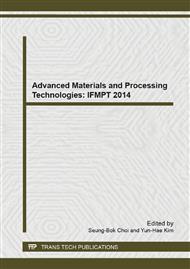[1]
J. Qiu, W. Duan: Large Electric Machine and Hydraulic Turbine in Chinese. Vol. 2 (2002), p.001.
Google Scholar
[2]
J. Yang, Y Kun and Z. Fu: Lubrication Engineering in Chinese. Vol. 32 (2007), p.68.
Google Scholar
[3]
S. Yang, J. Yang: Journal of Vibration and Shock. Vol. 27 (2008), p.161.
Google Scholar
[4]
W. Habchi, I. Demirci and D. Eyheramendy: Tribology International. Vol. 40 (2007), p.1466.
Google Scholar
[5]
Q. Tian, Y. Sun and C. Liu: Computers & Structures. Vol. 114 (2003), p.106.
Google Scholar
[6]
Z. Guo, T. Hirano and R. G. Kirk: Journal of Engineering for Gas Turbines and Power. Vol. 127 (2005), p.445.
Google Scholar
[7]
J. Zhang, H. Guo and B. Niu: Transactions of the Chinese Society for Agricultural Machinery in Chinese. Vol. 39 (2008), p.159.
Google Scholar
[8]
J. Shao, C. Dai and Y. Zhang: Journal of Hydrodynamics. Vol. 23 (2011), p.676.
Google Scholar
[9]
Y. Zhang, C. Dai and Y. Wang: Electronic and Mechanical Engineering and Information Technology (EMEIT), 2011 International Conference on. IEEE. Vol. 2 (2011), p.1083.
Google Scholar
[10]
F. Cui, W. Zhao and J. Yang: Bearings in Chinese. Vol. 1 (2009), p.32.
Google Scholar
[11]
J. Shao, Y. Zhang and Y. Li: Journal of Central South University of Technology English Edition. Vol. 15 (2008), p.245.
Google Scholar
[12]
J. Shao, C. Dai and Y. Zhan: Journal of Hydrodynamics. Vol. 23 (2011), p.676.
Google Scholar
[13]
Y. Zhang, J. Shao and S. Ni: China Mechanical Engineering in Chinese. Vol. 19 (2008), p.563.
Google Scholar
[14]
L. Lu, Z. Zhao and Y. Liang: 5th International Symposium on Advanced Optical Manufacturing and Testing Technologies. International Society for Optics and Photonics (2010).
Google Scholar
[15]
H. Yang, W. Zulehner: Lecture Notes in Computer Science. Vol. 5910 (2010), p.116.
Google Scholar
[16]
Q. Lin, Z. Wei, N. Wang and W. Chen: Tribology International. Vol. 64 (2013), P. 8.
Google Scholar
[17]
X. Yu, J. Wang and Y. Li: Advances in Materials Manufacturing Science and Technology XII Materials Science Forum. Vol. 628 (2009), p.281.
Google Scholar
[18]
P. Bhat, S. Shenoy and R. Pai: Proceedings of ASME/STLE International Joint Tribology conference, IJTC (2007), p.193.
Google Scholar
[19]
Y. Hong, D. Chen and X. Kong: Computer Methods in Applied Mechanics and Engineering in Chinese. Vol. 191 (2002), p.5231.
Google Scholar
[20]
S. Hao, X. Zhang and S. Wui: Journal of Anshan University of Science and Technology. Vol. 35 (2012), p.130.
Google Scholar
[21]
H. Liu, H. Xu and P. Ellison: Tribology Letters. Vol. 38 (2010), p.325.
Google Scholar


